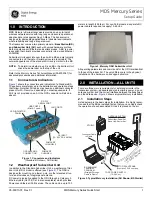
Operation
How the Transmitter Senses the Target Gas
Ambient air surrounding the transmitter housing diffuses inside the housing where it comes
into contact with the sensor. Although the transmitter’s circuitry dissipates very little power, a
small amount of heat is produced inside the housing. This heat causes air to rise up through
the bottom vent, past the sensor, and out the upper vent. Any target gas present in this air
causes a response from the sensor. If the transmitter is located properly, the sensor will
respond to the average amount of the target gas present in the area. For help in properly
locating the transmitter, please read the mounting guidelines on page 12. This transmitter
monitors the actual concentration of the target gas exposed to the sensor. This actual value
may be different than the time-weighted-average values displayed by many personal gas
monitors. Please take this difference into account when comparing the response of the two
units.
Factory Default Settings
Unless otherwise specified on the order form, the following settings will be used to configure
the analog proportional output of the transmitter.
Setting
Default
Analog Proportional Output Units
mA
Analog Proportional Output Signal
4-20 mA
Using the Analog Proportional Output
This Brasch Gas Transmitter is supplied with a linear proportional output that can be
connected to a building management controller or variable-frequency drive. This output can
produce either a current or voltage signal that is proportional to the concentration of the target
gas present at the sensor. By moving jumpers, located on the bottom, right corner of the
printed circuit board, the user can select from 4-20 mA, 2-10 VDC, 1-5 VDC, and 0.2-1 VDC
signals. This signal is available at the terminal strip TS3, located at the bottom, right corner of
the board. See figure 6 on page 26 for the terminal strip locations and signal mode selection
jumpers.
Unless otherwise specified, the transmitter is shipped from the factory with the selection
jumpers set in the 4-20 mA current loop mode. To change the mode to one of the voltage
modes, the JP2 selection jumper must be moved to the “Volts” pins. After this, the JP3 jumper
IOM02
Rev 1.0 – December 22, 2020
18












































